Uttar Pradesh: On the Road to Robust Revival
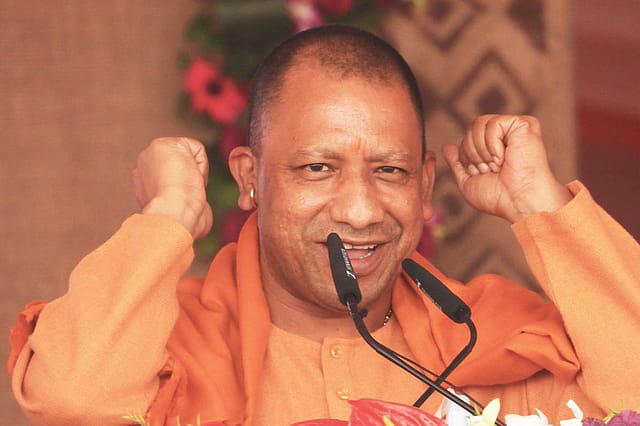
Uttar Pradesh has, of late, witnessed a series of pathbreaking development initiatives, which include inauguration of the first phase of Kashi Vishwanath Dham project, the foundation stone laying ceremony of the Ganga Expressway, apart from several other transformative projects. Presiding over these momentous occasions, Prime Minister Narendra Modi lauded Chief Minister Yogi Adityanath's ability to take up the most difficult challenges and solving them with exemplary good governance that has become synonymous with the BJP government in UP.
The Prime Minister exuded optimism that the day is not far when UP will be hailed as the most advanced state with a state-of-the-art infrastructure. He alluded to the network of expressways in UP, the new airports being built, and new rail routes being laid down as great blessings to the people of India's most populous state.
HERALDING CULTURAL RENAISSANCE
The PM dedicated the first phase of Kashi Vishwanath Dham, which has been constructed at a cost of about Rs 339 crore. The entire redevelopment of the ancient temple will cost a total of Rs 900 crore. The parliamentary constituency of PM Modi was decked up like a bride as the Varanasi corridor was illuminated creating an aura of divinity with the echoes of 'Har Har Mahadev' reverberating in the city of salvation!
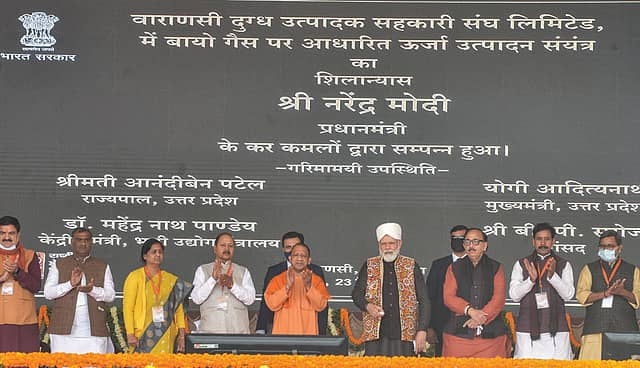
Lauding the CM Yogi for his incessant efforts to complete the Kashi Vishwanath Dham project, PM Modi said, "Kashi is a symbol of our spiritual soul. It is a symbol of India's antiquity, traditions, India's energy and dynamism.'' He also expressed his gratitude towards every labourer who worked for the construction of the grand complex and did not stop work even during the Covid pandemic. This initiative is seen to give a new direction to religious tourism and transformation of the region's economic landscape.
Today, the shrine with a golden dome stands grandly on a vast precinct measuring 5 lakh sq ft that can hold close to one lakh devotees at a time. The temple is constructed of sandstone, Chunar stone, Kota granite and Makrana marble with ornamental arches and magnificently carved colonnades, recapturing the lost glory of the holy site. Statues of Bharat Mata, Saint Adi Shankaracharya and Maharani Ahilyabai Holkar have been given a dedicated place in the sprawling temple complex.
The architecture of the temple matches the ambience of the surrounding area and retains the spirit of the sacred city. The project's blueprint envisages building of pilgrim facilitation centres, dormitories, museums, cafés, a common kitchen, a hospice for the elderly and infirm, galleries, a multipurpose hall for cultural and community events, a viewing gallery, a spiritual bookstore, a guesthouse and escalators for the elderly pilgrims and the physically challenged. More than 300 CCTV cameras and baggage scanners would keep the temple complex under surveillance and check.
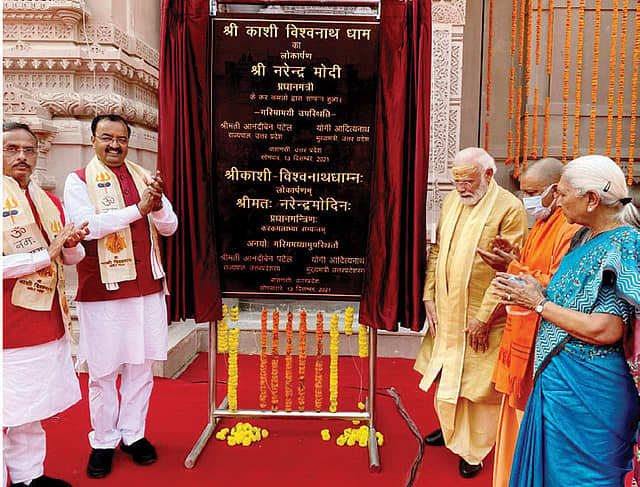
The length of the corridor starting from the temple to the ghats is 400m, with a width of 75m. The ghats in the vicinity such as Lalita Ghat, Manikarnika Ghat and Jalasen Ghat wear a new look. Once the entire temple project is completed, 70 percent of the area would have a green cover where mostly Rudraksha, Parijat, Ashok and Bael trees will be planted as they are believed to be the favourite trees of Lord Shiva.
THE EXPRESSWAY TO PHENOMENAL PROGRESS
In Shahjahanpur, the PM laid the foundation stone of the 594 km long Ganga Expressway to be built at a cost of about Rs 36,000 crore. Set to be the longest expressway in the country, Ganga Expressway will directly connect Eastern UP with Western UP. Starting from Meerut, the journey to Prayagraj via Hapur, Bulandshahr, Amroha, Sambhal, Badaun, Shahjahanpur, Hardoi, Unnao, Rae Bareli, and Pratapgarh will become a sheer pleasure.
An industrial corridor is proposed to be developed along the Ganga Expressway to give impetus to many sectors including industrial development, trade, agriculture, tourism etc. Further, nine public convenience centres, seven railway overbridges, 14 major and 126 minor bridges as well as 381 underpasses on the expressway would be made accessible by a 3.75-metre-wide service lane, for people residing along its route. Another unique feature of the all-weather expressway will be a 3.5-kilometre-long air-strip for use during emergency take-off and landing of Air Force planes in Shahjahanpur.
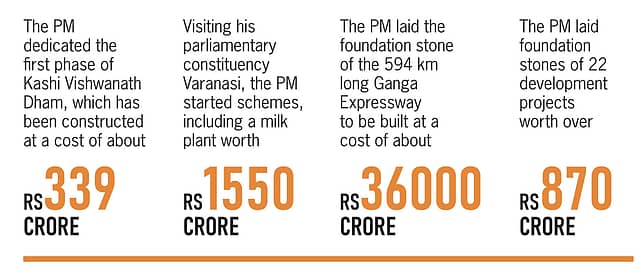
The people in Eastern as well as Western regions of UP stand to derive immense benefit through this growth corridor. "Ganga Expressway will bring new industries in this region," Prime Minister Modi said on the occasion of laying the foundation stone of the expressway, which would be the longest in UP, once it is built.
According to a statement released by the Prime Minister's Office, the expressway is being built in consonance with PM's vision to provide fast paced connectivity across the country that would bring numerous jobs and several new opportunities for thousands of youth in the state. The expressway project was approved on November 26, 2020, and will be dedicated to the nation by 2024.
The six-lane expressway would shorten the distance drastically by several hours from the Western UP to the Eastern region of the state.
By providing direct connectivity between Delhi NCR, several districts along the route and to the neighbouring state of Bihar at its eastern end, the ambitious project would serve to accelerate the pace of the state's economic development.
FAST-TRACKING DEVLOPMENT
Visiting his parliamentary constituency Varanasi, the PM recently announced schemes worth Rs 1550 crore including a milk plant. He laid the foundation stone of Banas Dairy Complex at Food Park of Uttar Pradesh State Industrial Development Authority in Karkhian, Varanasi in an effort to strengthen the rural economy and help the farmers of the region. The Prime Minister, ably supported by the Chief Minister, is constantly striving to spur the socio-economic development and progress of the state.
The Banas Dairy spread over 30 acres of land will be constructed at a cost of about Rs 475 crore and will have the facility to process 5 lakh litres of milk per day. This will create new opportunities for the farmers of the area. The Prime Minister digitally transferred the bonus of about Rs 35 crore to the bank accounts of over 1.7 lakh milk producers associated with Banas Dairy.
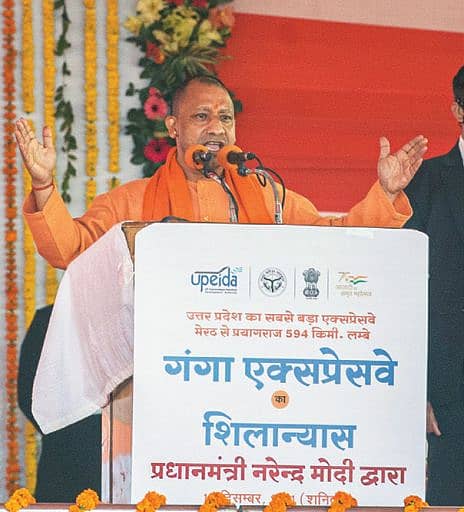
The PM also laid the foundation stone for the Biogas based Electricity generation project for the Milk Producers Cooperative Union Plant, Ramnagar, Varanasi. This will prove to be an important step in the direction of making the Plant self-reliant.
The Prime Minister also inaugurated a portal and logo dedicated to the Conformity Assessment Scheme for milk products developed by the Bureau of Indian Standards (BIS) with the help of the National Dairy Development Board (NDDB).The unified logo by combining both the BIS and NDDB quality marks is intended to simplify the certification process for the dairy sector and assure the public about the quality of the dairy products.
Meanwhile, in another effort to reduce land ownership issues at the grassroots level, the PM digitally distributed rural housing rights records 'Gharauni' under the ownership scheme of the Union Ministry of Panchayati Raj to over 20 lakh residents of UP. The PM laid foundation stones of 22 development projects worth over Rs 870 crore in Varanasi during the programme. This will give further impetus to the overall rejuvenation currently underway in Varanasi.
Several urban development projects inaugurated by the PM include six projects for redevelopment of wards of old Kashi, parking and parks in Beniyabagh, beautification of two ponds, sewage treatment plant at Ramna village and upgradation at 720 places under the Smart City Mission.
The PM also inaugurated projects related to the education sector including the Teacher Education Inter-University Centre of the Union Ministry of Education at a cost of about Rs 107 crore, and a Teacher Education Centre at the Central Institute of Higher Tibetan Studies at a cost of over Rs 7 crore.
Apart from this, the Prime Minister inaugurated residential flats and staff quarters at Banaras Hindu University and ITI Karaundi.
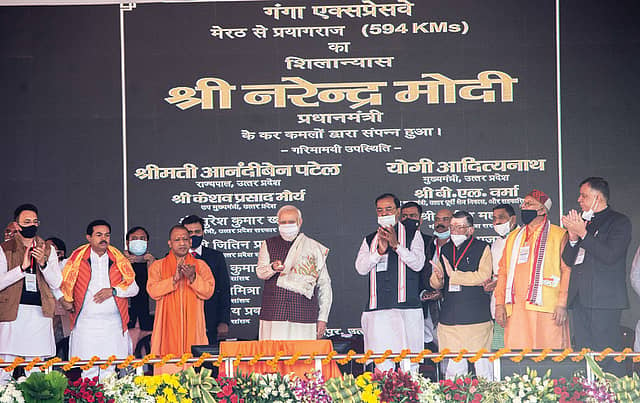
In the field of health, the PM inaugurated a project related to a doctor's hostel, a nurse's hostel and a shelter home at the Mahamana Pandit Madan Mohan Malviya Cancer Centre at a cost of Rs 130 crore. He inaugurated an integrated AYUSH hospital with 50 beds at Bhadrasi. Apart from this, the Prime Minister also laid the foundation stone of the Government Homeopathic Medical College to be built at a cost of Rs 49 crore in Pindra Tehsil under the AYUSH Mission.
In the road sector, the Prime Minister laid the foundation stone for two '4 to 6 lane' road widening projects for the roads leading to Prayagraj and Bhadohi. This will improve connectivity of Varanasi and prove be an important step towards solving the problem of traffic jam in the city.
The PM inaugurated the first phase of the tourism development project related to Shri Guru Ravidas Temple and Rishi Govardhan in Varanasi. He inaugurated other projects which include Speed Breed (SpeedBreed) facility at IRRI South Asia Regional Centre (ISARC), an international rice research centre in Varanasi. It will accelerate the breeding of new crop varieties, and help Indian farmers increase their incomes and be less vulnerable to climate change effects. The other projects inaugurated by the PM included a Regional Approval Standards Laboratory in Payakpur village and Advocates Bhawan in Pindra Tehsil.
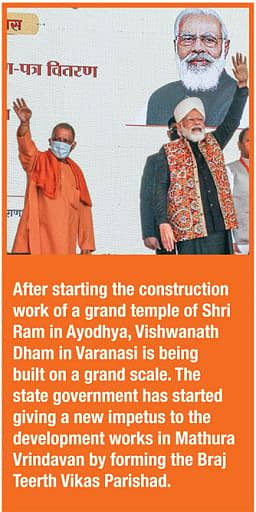
PM Modi launched a new section of Rs 11,000 crore metro project in Kanpur. He was accompanied by CM Yogi and Union Minister Hardeep Singh Puri as he undertook the ride from the IIT-Kanpur to Geeta Nagar station. This nine-km long section was completed in a record two years' time. The entire length of the Metro project in Kanpur is 32 km.
HAILING THE STATE LEADERSHIP
Lauding Chief Minister Yogi Adiytanath's ceaseless hard work to ensure holistic development of UP, PM Modi said, "The day is not far when UP will be identified as the most modern state with next-generation infrastructure. The network of expressways, the new airports being built, new rail routes being laid down are bringing several blessings to the people of UP simultaneously."
He added, "The modern infrastructure coming up in UP shows how resources are utilised. Today, work is being done on such projects so that hard-earned money of the people of UP can be saved. So that your money remains in your pocket."
LOOKING AHEAD
It is a matter of utmost significance that after starting the construction work of a magnificent Shri Ram temple in Ayodhya, Vishwanath Dham in Varanasi is being built on a grand scale. Giving credit to the BJP government and PM Modi for reclaiming the glory of ancient sites and monuments, CM Yogi has said that the restoration of Mathura Vrindavan to its ancient grandeur is not far away. The state government has started giving a new thrust to the development works in Mathura Vrindavan by forming the Braj Teerth Vikas Parishad. The Parishad aims at preserving, developing and maintaining the aesthetic quality of Braj culture in all hues – cultural, ecological, and architectural – and for evolving harmonised policies for integrated tourism development, heritage conservation and management in the region.
(A marketing initiative by Open Avenues)